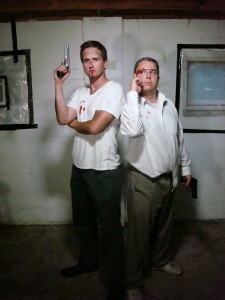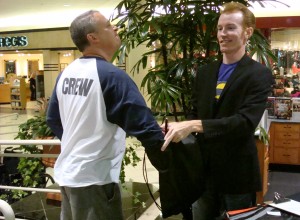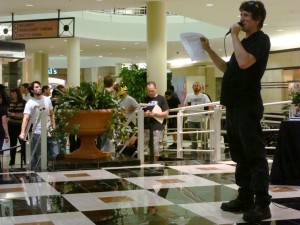48 Hour Film Project
The fastest films in Florida
The 48 Hour Film Project returns to Orlando
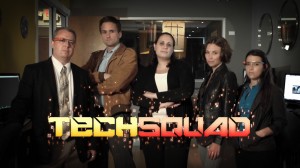 From The Orlando Weekly, September 3, 2013
From The Orlando Weekly, September 3, 2013
This is the first part of my extensive coverage of the 2013 48 Hour Film Project, which included a follow-up blog and story on the international competition, Filmapalooza, held in New Orleans in March 2014. See YouTube to view TechSquad.
Time was not on his side. In just 48 hours, TL Westgate, along with his team of 12 crew members and actors, had to write, shoot and edit a short film. It was an exercise in drive, discipline and insanity, all for the self-satisfaction it brought – along with the opportunity to see the finished film this week at Premiere Cinemas at Fashion Square Mall and the remote chance it will advance to the 2014 New Orleans Filmapalooza, where it could win $5,000 and eventually be shown at the Cannes Film Festival.
But TL was not alone. Thirty-five other filmmaking teams subjected themselves to the same challenge from 7 p.m. on Friday, August 23, to 7:30 p.m. on Sunday, August 25, hoping their film would rise above the rest. And this year more than 120 other cities also took part, making the 48 Hour Film Project the world’s largest timed moviemaking competition.
How it works
Teams can come together, select shooting locations and secure equipment in advance, but no writing or production can begin before the kick-off event. Cheating is possible and has occurred in the past without repercussions, but the Project makes that difficult by having teams draw one of 14 genres (slightly different each year), from general ones such as comedy or drama, to specific ones like crime/gangster or mistaken identity. Films must also incorporate elements that are revealed at kick-off: a prop (a tablet this year), a character name and trait (Don or Donna Bleshing, a tightwad) and a line of dialogue (“Terrific. That is just terrific.”).
Movies must run 4-7 minutes, not counting end credits, and adhere to certain technical requirements, such as resolution, aspect ratio and frame rate (surprisingly, 30fps instead of 24). No stock footage may be used, and no one may receive compensation, not even SAG-AFTRA actors. In addition, the Project shares copyright, regardless of whether the films go on to other festivals.
All movies are shot digitally, rendered as digital files and submitted on DVD or flash drive. (Since the Project began in Washington, D.C., in 2001, only three groups – none in Orlando – have been ambitious enough to shoot on film.)
“I got wind of it through fellow filmmakers back in 2008 when the 48 Hour Film Project first came to Orlando, so I was there for the inaugural Orlando one, and I was part of another team,” says TL. “I had always toyed around with short films, and I got my degree in media production, … so this official team environment for a contest sort of got my juices flowing, and from then on I’ve not stopped making films.”
He’s clearly learned from his previous experiences, with include directing audience-award winner and overall runner-up for 2010, Beachwatch, a mockumentary and Baywatch spoof.
“The biggest challenge is writing a script that’s shootable in the allotted time,” TL says. “You can’t overwrite. You can’t be too ambitious with such a limited amount of time.”
Like TL, local filmmakers Allen Paschel and Aimee Maynard have participated before.
“It’s fun and extremely stressful at the same time,” Allen says. “Story is the biggest challenge. Second is definitely editing. … I typically don’t sleep until we are well on our way to having a final draft.”
Adding to Allen’s sleepless nights last year were endless disasters, starting with the assignment of Western, an often difficult genre, and continuing until about half of his 16-member team dropped out. His chances of success were dampened further when a water main broke at his shooting location, but he still finished the film.
Aimee’s experiences have not been trouble-free either. “Last year the people in my group kind of disappeared, so I went to a meet-up and met six guys from Full Sail [University], and they had a group, so I joined them,” she says. “[This year] I’ve been feeling pressure because we have a lot of professionals. Very serious people are coming on board. Normally, I just, like, don’t care – we’re gonna make a good movie or make the best we can, and have something nice for our portfolio.”
Rob Ward, the Orlando Project director since 2010, says the biggest filmmaker problems he’s seen are clashing egos and computer problems, such as rendering. But for him, the problems are different.
“[My biggest challenge] is trying to find local sponsors who will help out with the cost. It’s pretty much non-existent,” Rob says. “My challenge pretty much starts when they drop off the project, because then I have to edit them all together.”
A Project play-by-play
Upon Rob’s suggestion, I “embedded” with a group. Having chosen TL’s team (Creative Inlet Films) a few weeks in advance, it’s now Friday, August 23, at 7 p.m., and I’m waiting nervously with them to discover our assignment. (Though I’m shadowing and not providing input, I feel emotionally invested too. How could I not be? After all, I’d been hanging out with TL and other filmmakers at the multiple meet-and-greets in July and August, which fostered team-building and introduced filmmakers to actors, and vice versa.)
After receiving the informational packet – TL had paid his $140 entry fee weeks before – and watching other teams draw genres, TL is ready to do the same. “I get nervous pulling the genre,” he confides. “My heart is beating.”
He draws buddy film. “OK, we can do this,” the director says, obviously relieved he got something he could turn into comedy, his preferred genre.
Not every team is as happy. Allen draws fantasy and is clearly not in a magical mood. But he, like all team leaders except one who drew “musical or Western,” chooses to keep his pick and not opt for one of the nine slightly off-the-wall wild cards, such as martial arts, zombie and B movie.
Amazingly, TL and Michelle Bretana (his writing partner, assistant director and script supervisor) have the basic idea planted in their brains when the group convenes for dinner at Tijuana Flats at 8 p.m. Between flautas and burritos, the concept becomes clearer: A hero cop and his tech-savvy, nerdy, Google Glass-wearing partner thwart the evil plans of a pair of James Bond-like villains. It’ll have action and suspense, but mostly it will showcase outrageous comedy, thanks to – spoiler alert! – a missile homing device implanted in the nether regions of a kidnapped cop. It’s “Lethanal Weapon,” if you will, although an admittedly PG-13 one, to conform to the standards of the Project, which stipulate no nudity or excessive use of adult language (although Rob admits a few entries this year push those limits, so parents beware).
“Let’s fool the audience into thinking it’s all action, and then get goofy,” TL says. “Kick ‘em in the comedic balls.”
By 8:30 p.m., we have a title: TechSquad. And finally joining us for dinner are the two villain actors, Christina Carmona and Nando Luis Torres, the latter having rushed here from his tech-school graduation ceremony.
At 9 p.m., the conversation turns technical, and cinematographer Corey Steib gets involved, discussing lighting, lenses and set-ups with TL. At 10:30 p.m., after more discussion about costumes and plot, the group disbands, slightly giddy and loopy, but the screenplay isn’t finished until 4 a.m., allowing Michelle – who, in her first significant film role, will also play the police captain – just one hour of sleep. TL doesn’t do much better, getting just three hours of fitful rest.
Saturday is shooting day, and we arrive, eager but sleep deprived, at the offices of graphics company Edge Factory, which, conveniently, TL and a couple of other crew members have access to. It will serve nicely as police office and missile-control room.
The camaraderie is evident, as all actors come early, even those whose scenes won’t be shot until the afternoon. Showing up for the first time this morning are two actresses TL has worked with before, Brittany Isham and Amanda Powell, who will play a second pair of buddy cops, and Hans Christianson, who, as Agent Bleshing, will be imprisoned, chained and beaten by the two villains – the day after receiving a vasectomy in real life. Talk about dedication.
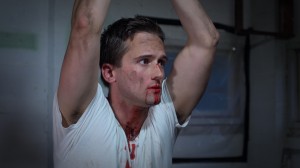 At 9:05 a.m., the shoot begins with green-screen work that graphics and animation supervisor Grayson Blackmon will turn into the film’s intro. At 10 a.m., after TL confers with cinematographer Corey and camera operator Jay De Los Santos, the true filming begins and doesn’t stop until we break for lunch, hungry and a bit weary, at 1:30 p.m. But despite the weariness, TL, often joking, can’t resist a sarcastic barb to his actors: “They say never work with children or animals. I’m working with both.”
At 9:05 a.m., the shoot begins with green-screen work that graphics and animation supervisor Grayson Blackmon will turn into the film’s intro. At 10 a.m., after TL confers with cinematographer Corey and camera operator Jay De Los Santos, the true filming begins and doesn’t stop until we break for lunch, hungry and a bit weary, at 1:30 p.m. But despite the weariness, TL, often joking, can’t resist a sarcastic barb to his actors: “They say never work with children or animals. I’m working with both.”
An hour’s lunch at Chili’s is our only downtime. And in the proud workaholic tradition of Chaplin, Kubrick and Kazan, TL turns to me while eating and exclaims, “I haven’t peed yet today.”
At 4 p.m., after a furious rainstorm and a trip to a Halloween store to buy fake blood, shooting begins at the other location, a small hut in Grayson’s backyard. It’s a structure so creepy it’s dubbed the “murder shack.” It needs no dressing.
Rehearsals precede the shooting, and exhaustion and nerves emerge. “We’re all in a daze land right now,” Michelle says, while Christina, who eventually plays her evil part to perfection, is struggling with lines, thanks to her revealing, restrictive costume and the fact that she, like the other actors, first saw the script that morning.
“I’m sorry. I can’t do this right now. My tits are out,” she says. “I just need to look at [the script again]. I don’t know what’s wrong with me.”
At 5:15 p.m., we’re ready to film the scene in which Hans is chained – for real, thanks to advice from sound technician Danny Page, who doubles as weapons specialist – to the rafters of the shack and repeatedly fake-punched by Nando. After multiple takes, though, their timing falters and Nando really punches Hans in the mouth – a take regrettably not useable in the final cut – allowing a drop of real blood to mix with the fake.
Hans: “I can taste the blood.” Nando: “If the freaking audience doesn’t like this scene …”
Technical challenges are overcome on the fly. “Good ol’ gaff tape,” proclaims production manager Jen Vargas. “There’s nothing it can’t do.” Adds camera operator Jay: “I saw gaff tape deliver a baby once, like Doogie Howser.”
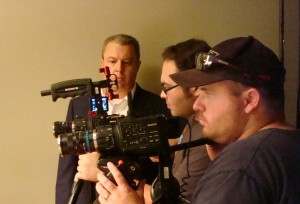
From left, TL, Corey and Jay plan a shot. All photos copyright Cameron Meier/Creative Inlet Productions.
With no natural light left, shooting wraps at 8:15 p.m., with Hans in just a bit of pain and Corey’s shoulders not too sore thanks to a comfortable spider brace for his Sony FS 100 camera.
Though the actors, cameramen and audio techs are done, in many ways the work is just beginning for TL on Saturday night and into Sunday. And it’s solitary work, indeed, as the director-turned-editor labors over the right takes, the right audio levels and the right royalty-free music choices, using Adobe Premiere and Adobe Audition to cobble together a finished film.
The only other team members still working are Michelle, creating credits; Grayson, finishing graphics; and Jen and Jay, re-shooting footage of a moving car with their versatile GoPro camera. Jay even doubles as last-minute voice-over talent.
TL is clearly in his element. “I heard the boom pole,” he notes. “I need to use a different take.” Minutes later: “I just combined two sound effects to make a new one!”
Despite joking at 1:50 p.m. that “I’m going to kill somebody today,” by 4:10 p.m. TL has finally finished and invites the group to an impromptu screening in his living room. “I’d like to spend another week tweaking,” he says, “but for this event, it’s good.”
Drop-off and screening
For the group I was embedded with, the hard work and sleep deprivation paid off. After a couple of last-minute sound tweaks, they turned in their finished film at 7:20 p.m., relieved and ready for food and drink – and then sleep.
But what about Allen Paschel, the guy who was unhappy with his genre? Well, he also finished his film, Tablet Racers, on time, thanks to “more planning than we ever had before” – without breaking anymore water mains. “We almost caused a fire, though,” he admitted. “It was kind of scary.”
Not all teams were so lucky. Of the 36 that entered, 13 didn’t make the deadline, including Aimee Maynard, who, before this year’s Project began, admitted she was feeling the pressure. She turned in her film five minutes late.
“We drew holiday/vacation. It was an easy [genre], so I was totally unprepared,” Aimee joked. “We wrote the script early, and some of the team members [26 in all, far above the average size of 6-15] weren’t happy, … so we struck on something else.”
But the writing delays put time pressure on filming, culminating in the walk-off of two of her directors of photography. However, she says she is still able to appreciate the fact that her film (the Christmas-themed Heart Strings), though tardy and therefore disqualified from receiving judges’ awards or advancing to New Orleans, was finished and will screen in the B group on Thursday.
“We’re happy with what we’re turning in,” she says.
And why shouldn’t she be? After all, thanks to years of being spoiled to a lengthier process and big budgets, would famous filmmakers be up for a similar challenge? In an interview for the DVD release of his 1971 classic Duel – a 74-minute movie that he was forced to shoot in less than two weeks and edit in three – Steven Spielberg admitted he might not be.
“I look back at it, … saying how did I get all those shots in 12 or 13 days? How is that possible? If I had to go back right now and re-create Duel in 12 to 13 days, I don’t think I could do it – impossible,” he says. “I think I was so hungry back then; I was so ambitious; I was so excited about having been given this chance. I couldn’t do it that way again today, which means a lot of the spontaneity would be left out.”
Spontaneity is certainly something the 48 Hour Film Project doesn’t lack. Whether it lacks quality is something you will have to discover when you attend the public screenings. Group A, which includes TL’s and Allen’s films, is at 7 p.m. on Sept. 4, with group B at 7 p.m. on Sept. 5, followed immediately by group C around 8:30 p.m. Tickets for a single group are $10; a pass to all groups is $25.
What next?
Of course, TL and the other filmmakers hope to win the Orlando competition and go on to future fame. But if they don’t, what can they take away from the Project?
“What I’ve heard over and over is the fun of it, how much fun they have and how much they love making films,” Rob says, adding that he’s pleased all 36 groups eventually turned in films and will get to see their work screened.
TL agrees. “Painters paint, and they don’t necessarily show all of their stuff to galleries or sell it. It’s in them and it wants to come out,” he says. “I just want to make short films. I have no aspirations that the 48-hour film I make this year or any year is going to make somebody in Hollywood call me. But I like the collaboration process. I like working with new actors. I like getting something out that we can show people and be proud of. … For me, it’s another film I can put on my demo reel and show people what I can do.”
While his long-term future is uncertain, we at least know what TL will be doing in the coming days.
“After a good night’s sleep, the haze of the 48 had worn off and it struck me: I could just go outside and run across my lawn with my audio recorder [to fix one last audio problem],” he says. “The tweaks continue for the version we’ll get to put on YouTube after the premieres.”
And so TL the tinkerer is never quite able to let the project rest. The editing goes on, and the process never truly ends. But at least he’ll be able to eat and sleep a bit better now.
© 2014 Orlando Weekly / MeierMovies, LLC
